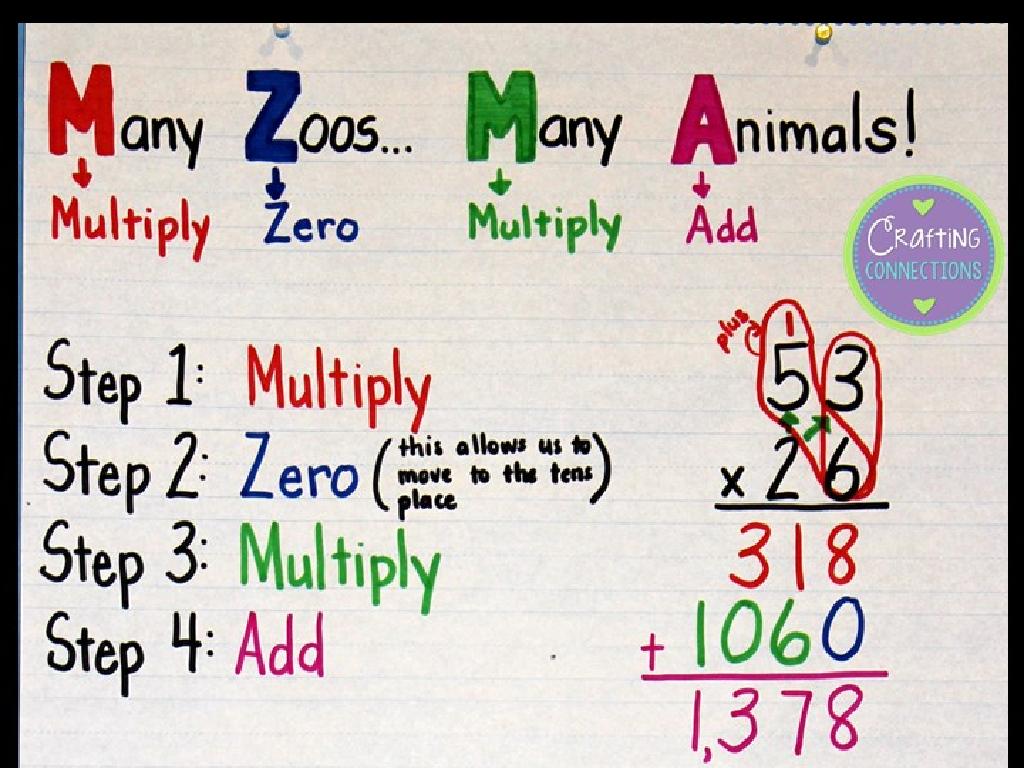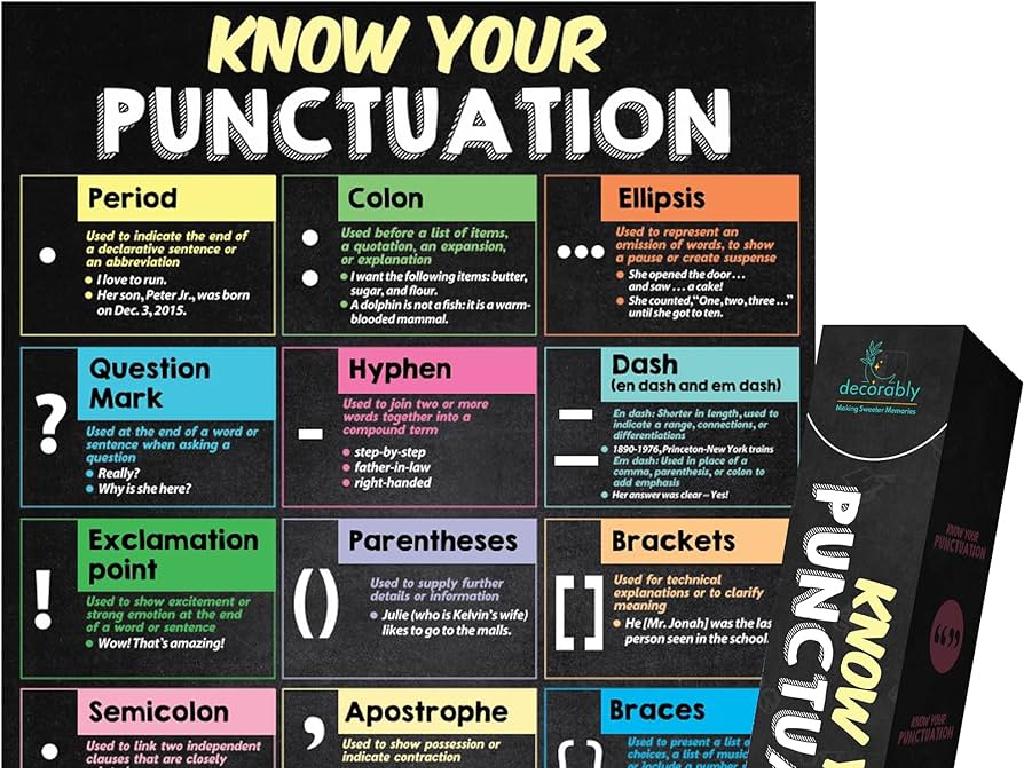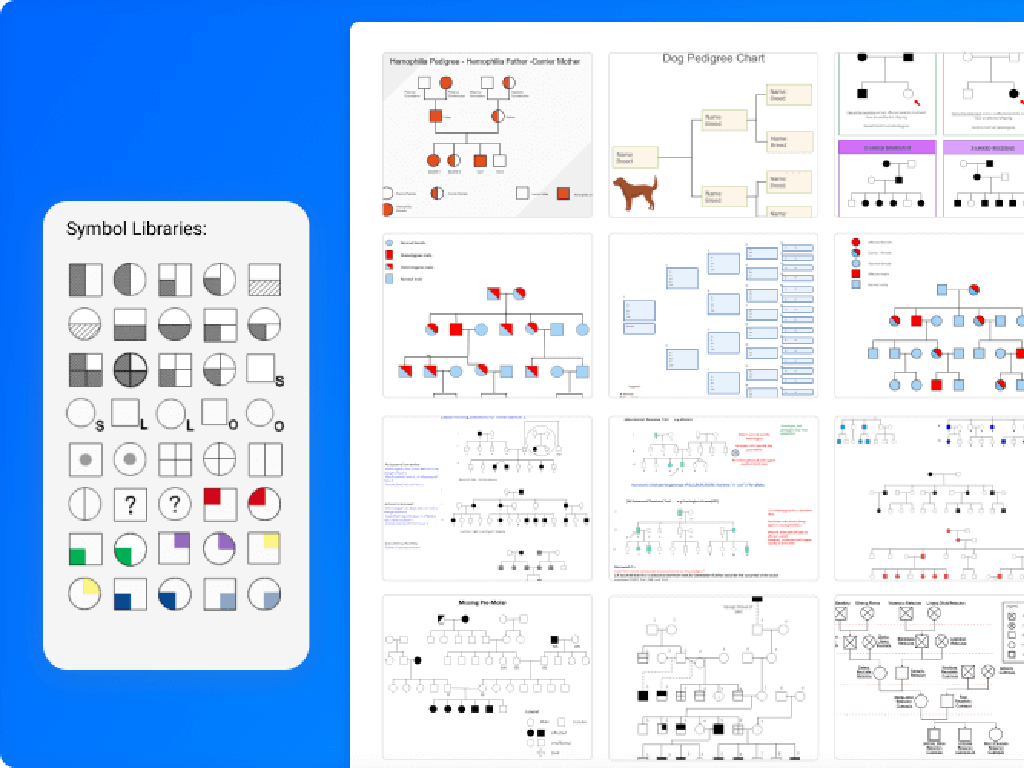Compare Cells And Cell Parts
Subject: Science
Grade: Eighth grade
Topic: Cells
Please LOG IN to download the presentation. Access is available to registered users only.
View More Content
Welcome to the World of Cells!
– Cells: Life’s Building Blocks
– Basic unit of life, found in all living things.
– Cells’ role in organisms
– Essential for life functions and processes.
– Comparing cell structures
– Different types have various shapes and parts.
– Preview of cell comparison
|
This slide introduces the fundamental concept of cells as the basic building blocks of all living organisms. Emphasize the importance of cells in the structure and function of all life forms. Highlight that cells come in diverse forms and have different parts, which we will compare in today’s lesson. Encourage students to think about the variety of cells they already know and how these might differ from one another. The goal is to set the stage for a deeper dive into the similarities and differences between various cell types and their components, fostering an understanding of the complexity and diversity of life at the cellular level.
Exploring the Building Blocks of Life: Cells
– Define a cell
The basic unit of life, fundamental to all living things.
– Cells’ role in organisms
Cells are the smallest living units that make up all organisms.
– Compare cell types
There are two main cell types with distinct characteristics.
– Prokaryotic vs. Eukaryotic
Prokaryotic cells lack a nucleus, while Eukaryotic cells have a nucleus.
|
This slide introduces students to the concept of cells as the fundamental units of life. It’s crucial to define what a cell is and to explain that every living organism is made up of cells. Highlight the role of cells as the building blocks of life, responsible for carrying out essential functions to sustain life. Discuss the two primary types of cells: Prokaryotic, which are simpler and found in organisms like bacteria, and Eukaryotic, which are more complex and make up plants, animals, and humans. Emphasize the differences between these cells, particularly the presence of a nucleus in Eukaryotic cells. This foundational knowledge sets the stage for understanding the complexity and diversity of life at the cellular level.
Cell Parts and Functions
– Common parts of a cell
– Nucleus, cytoplasm, cell membrane
– Functions of each part
– Nucleus: controls cell; Cytoplasm: holds components; Membrane: protects cell
– Specialized cell parts
– Unique parts for specific functions
– Chloroplasts vs. mitochondria
– Chloroplasts in plants for photosynthesis; Mitochondria in animals for energy
|
This slide aims to compare the different parts of a cell and their functions, highlighting the similarities and differences between plant and animal cells. Students should understand that while all cells share common structures such as the nucleus, cytoplasm, and cell membrane, they also have specialized parts that perform specific functions. For instance, chloroplasts are unique to plant cells and are essential for photosynthesis, whereas mitochondria are found in animal cells and are crucial for energy production. Encourage students to think about how these differences in cell parts reflect the different roles and environments of plant and animal cells. Use diagrams to visually represent the cell parts during the presentation.
Comparing Plant and Animal Cells
– Similarities in cells
– Both have a nucleus, cytoplasm, and mitochondria.
– Key differences highlighted
– Plant cells have a cell wall, chloroplasts, and large vacuoles.
– Significance of differences
– Cell wall provides support; chloroplasts enable photosynthesis; large vacuoles store nutrients.
– Functionality linked to structure
|
This slide aims to compare and contrast plant and animal cells, focusing on their similarities and key differences. Both cell types share several structures, such as the nucleus, which houses DNA, and mitochondria, the energy-producing centers. However, plant cells have unique features like the cell wall for added support and protection, chloroplasts for photosynthesis, and large vacuoles for storage. These differences are crucial for the cells’ specialized functions – the cell wall maintains the plant’s upright structure, chloroplasts convert sunlight into energy, and vacuoles store water and nutrients. Understanding these differences helps students appreciate how structure and function are interrelated in biology. Encourage students to think about how these differences affect the overall organism’s survival and adaptation to its environment.
Microscopic Investigation of Cells
– Scientists’ use of microscopes
– Microscopes magnify cells to study structures
– Historical discovery of cells
– Cells were first observed by Robert Hooke in 1665
– Viewing cells under a microscope
– Examples: Cheek cells, onion skin cells, leaf cells
– Comparing different cell types
– Observe size, shape, and organelle differences
|
This slide aims to give students an understanding of how microscopes have opened up the world of cells to scientific study. Begin with a brief history of cell discovery, highlighting Robert Hooke’s first observation of cells in a cork. Discuss the evolution of microscopes and how they allow us to see cells, which are too small to be seen with the naked eye. Show examples of different types of cells that can be observed under a microscope, such as animal cells (cheek cells), plant cells (onion skin, leaf cells), and discuss the similarities and differences among them. Emphasize the importance of comparing cell parts, such as the cell wall in plant cells and the lack of it in animal cells, to understand cell function and structure.
Cell Organelles and Their Functions
– Explore cell organelles
– Mitochondria, ribosomes, endoplasmic reticulum, and more
– Unique roles of organelles
– Each organelle has a specific function, like energy production or protein synthesis
– Organelle collaboration
– Organelles interact for cell survival, growth, and replication
– Impact on overall cell function
|
This slide aims to provide students with a deeper understanding of the various cell organelles and their specific roles within the cell. Discuss the mitochondria as the powerhouse of the cell, ribosomes as the site of protein synthesis, and the endoplasmic reticulum as the transport network. Emphasize how these organelles, although having unique functions, must work in harmony for the cell to operate efficiently. This understanding is crucial for comprehending more complex biological processes and systems. Encourage students to think of the cell as a factory, with each organelle performing a vital job to keep the factory running smoothly.
Class Activity: Cell Model Creation
– Create a 3D cell model
– Choose plant or animal cell
– Use craft supplies for parts
– Clay for cell body, beads for organelles, strings for membranes
– Represent parts and functions
– Label each part, like nucleus, mitochondria, and explain its role
|
This hands-on activity is designed to help students identify and understand the structure and function of cell parts. By creating a 3D model, students will visually and tactilely engage with the components of plant or animal cells. Provide a variety of craft supplies and encourage creativity while ensuring accurate representation of each cell part. Students should label each part of their cell model and be prepared to explain the function of each organelle. For example, the nucleus can be represented by a large bead, acting as the control center of the cell, while mitochondria, represented by smaller beads, can be explained as the powerhouses of the cell. This activity caters to different learning styles and promotes comprehension through interactive learning.
Cellular Recap: Structure and Function
– Review cell part functions
– Recap nucleus, mitochondria, ribosomes, etc. and their roles
– Significance in biology
– Understanding cells is key to grasping life’s processes
– Encourage cell curiosity
– Questions about cells
– What questions do you have about cells?
|
This slide aims to summarize the key points from our lesson on cells. Start by reviewing the various cell parts such as the nucleus, which acts as the control center; mitochondria, the powerhouse of the cell; and ribosomes, the protein factories. Emphasize the importance of understanding cell structure as it is fundamental to all biological sciences and is crucial for understanding how organisms function, grow, and reproduce. Encourage students to ask questions and explore their curiosity about cells, as this is the basis for scientific discovery and understanding. Prepare to address common questions and perhaps provide additional resources for interested students to learn more.
Homework: Dive into Cell Biology
– Complete cell comparison worksheet
– Research an organelle for presentation
– Pick any organelle, like the nucleus or mitochondria, and explore its functions
– Reminder: Bring cell model to class
– Share your findings next class
– Be prepared to discuss how your organelle contributes to the cell’s overall operation
|
This homework assignment is designed to reinforce the concepts learned about cells and their components. The cell comparison worksheet will help students identify similarities and differences between various cell types and organelles. Encourage students to choose an organelle that interests them and to delve into its specific role within the cell. They should prepare a brief presentation to share their findings, which will help develop their research and public speaking skills. Additionally, remind students to bring their cell models to the next class; these models will serve as a visual aid during their presentations and enhance their understanding of cell structure and function. Provide a list of resources where students can find reliable information for their research.






